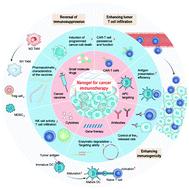当前位置:
X-MOL 学术
›
Chem. Soc. Rev.
›
论文详情
Our official English website, www.x-mol.net, welcomes your
feedback! (Note: you will need to create a separate account there.)
Bioengineered nanogels for cancer immunotherapy
Chemical Society Reviews ( IF 40.4 ) Pub Date : 2022-06-06 , DOI: 10.1039/d2cs00247g Xianbin Ma 1 , Shu-Jin Li 2 , Yuantong Liu 2 , Tian Zhang 1 , Peng Xue 1 , Yuejun Kang 1 , Zhi-Jun Sun 2 , Zhigang Xu 1
Chemical Society Reviews ( IF 40.4 ) Pub Date : 2022-06-06 , DOI: 10.1039/d2cs00247g Xianbin Ma 1 , Shu-Jin Li 2 , Yuantong Liu 2 , Tian Zhang 1 , Peng Xue 1 , Yuejun Kang 1 , Zhi-Jun Sun 2 , Zhigang Xu 1
Affiliation

|
Recent years have witnessed increasingly rapid advances in nanocarrier-based biomedicine aimed at improving treatment paradigms for cancer. Nanogels serve as multipurpose and constructed vectors formed via intramolecular cross-linking to generate drug delivery systems, which is attributed predominantly to their satisfactory biocompatibility, bio-responsiveness, high stability, and low toxicity. Recently, immunotherapy has experienced unprecedented growth and has become the preferred strategy for cancer treatment, and mainly involves the mobilisation of the immune system and an enhanced anti-tumour immunity of the tumour microenvironment. Despite the inspiring success, immunotherapeutic strategies are limited due to the low response rates and immune-related adverse events. Like other nanomedicines, nanogels are comparably limited by lower focal enrichment rates upon introduction into the organism via injection. Because nanogels are three-dimensional cross-linked aqueous materials that exhibit similar properties to natural tissues and are structurally stable, they can comfortably cope with shear forces and serum proteins in the bloodstream, and the longer circulation life increases the chance of nanogel accumulation in the tumour, conferring deep tumour penetration. The large specific surface area can reduce or eliminate off-target effects by introducing stimuli-responsive functional groups, allowing multiple physical and chemical modifications for specific purposes to improve targeting to specific immune cell subpopulations or immune organs, increasing the bioavailability of the drug, and conferring a low immune-related adverse events on nanogel therapies. The slow release upon reaching the tumour site facilitates long-term awakening of the host's immune system, ultimately achieving enhanced therapeutic effects. As an effective candidate for cancer immunotherapy, nanogel-based immunotherapy has been widely used. In this review, we mainly summarize the recent advances of nanogel-based immunotherapy to deliver immunomodulatory small molecule drugs, antibodies, genes and cytokines, to target antigen presenting cells, form cancer vaccines, and enable chimeric antigen receptor (CAR)-T cell therapy. Future challenges as well as expected and feasible prospects for clinical treatment are also highlighted.
中文翻译:

用于癌症免疫治疗的生物工程纳米凝胶
近年来,基于纳米载体的生物医学取得了越来越快的进展,旨在改善癌症的治疗模式。纳米凝胶用作多用途和构建的载体,通过分子内交联产生药物传递系统,这主要归因于它们令人满意的生物相容性、生物响应性、高稳定性和低毒性。近年来,免疫治疗经历了前所未有的发展,已成为癌症治疗的首选策略,主要涉及免疫系统的调动和肿瘤微环境的抗肿瘤免疫增强。尽管取得了令人鼓舞的成功,但由于反应率低和免疫相关不良事件,免疫治疗策略受到限制。与其他纳米药物一样,纳米凝胶在通过引入生物体时受到较低的焦点富集率的限制注射。由于纳米凝胶是三维交联的水性材料,具有与天然组织相似的特性并且结构稳定,它们可以舒适地应对血液中的剪切力和血清蛋白,更长的循环寿命增加了纳米凝胶在体内积累的机会。肿瘤,赋予深度肿瘤穿透。大的比表面积可以通过引入刺激响应官能团来减少或消除脱靶效应,允许针对特定目的进行多种物理和化学修饰,以提高对特定免疫细胞亚群或免疫器官的靶向性,提高药物的生物利用度,以及赋予纳米凝胶疗法较低的免疫相关不良事件。到达肿瘤部位后的缓慢释放有利于宿主免疫系统的长期觉醒,最终达到增强的治疗效果。作为癌症免疫治疗的有效候选者,基于纳米凝胶的免疫治疗已被广泛使用。在这篇综述中,我们主要总结了基于纳米凝胶的免疫疗法的最新进展,以提供免疫调节小分子药物、抗体、基因和细胞因子,靶向抗原呈递细胞,形成癌症疫苗,并实现嵌合抗原受体 (CAR)-T 细胞治疗。 . 还强调了未来的挑战以及临床治疗的预期和可行前景。我们主要总结了基于纳米凝胶的免疫疗法的最新进展,以提供免疫调节性小分子药物、抗体、基因和细胞因子,靶向抗原呈递细胞,形成癌症疫苗,实现嵌合抗原受体 (CAR)-T 细胞治疗。还强调了未来的挑战以及临床治疗的预期和可行前景。我们主要总结了基于纳米凝胶的免疫疗法的最新进展,以提供免疫调节性小分子药物、抗体、基因和细胞因子,靶向抗原呈递细胞,形成癌症疫苗,实现嵌合抗原受体 (CAR)-T 细胞治疗。还强调了未来的挑战以及临床治疗的预期和可行前景。
更新日期:2022-06-06
中文翻译:

用于癌症免疫治疗的生物工程纳米凝胶
近年来,基于纳米载体的生物医学取得了越来越快的进展,旨在改善癌症的治疗模式。纳米凝胶用作多用途和构建的载体,通过分子内交联产生药物传递系统,这主要归因于它们令人满意的生物相容性、生物响应性、高稳定性和低毒性。近年来,免疫治疗经历了前所未有的发展,已成为癌症治疗的首选策略,主要涉及免疫系统的调动和肿瘤微环境的抗肿瘤免疫增强。尽管取得了令人鼓舞的成功,但由于反应率低和免疫相关不良事件,免疫治疗策略受到限制。与其他纳米药物一样,纳米凝胶在通过引入生物体时受到较低的焦点富集率的限制注射。由于纳米凝胶是三维交联的水性材料,具有与天然组织相似的特性并且结构稳定,它们可以舒适地应对血液中的剪切力和血清蛋白,更长的循环寿命增加了纳米凝胶在体内积累的机会。肿瘤,赋予深度肿瘤穿透。大的比表面积可以通过引入刺激响应官能团来减少或消除脱靶效应,允许针对特定目的进行多种物理和化学修饰,以提高对特定免疫细胞亚群或免疫器官的靶向性,提高药物的生物利用度,以及赋予纳米凝胶疗法较低的免疫相关不良事件。到达肿瘤部位后的缓慢释放有利于宿主免疫系统的长期觉醒,最终达到增强的治疗效果。作为癌症免疫治疗的有效候选者,基于纳米凝胶的免疫治疗已被广泛使用。在这篇综述中,我们主要总结了基于纳米凝胶的免疫疗法的最新进展,以提供免疫调节小分子药物、抗体、基因和细胞因子,靶向抗原呈递细胞,形成癌症疫苗,并实现嵌合抗原受体 (CAR)-T 细胞治疗。 . 还强调了未来的挑战以及临床治疗的预期和可行前景。我们主要总结了基于纳米凝胶的免疫疗法的最新进展,以提供免疫调节性小分子药物、抗体、基因和细胞因子,靶向抗原呈递细胞,形成癌症疫苗,实现嵌合抗原受体 (CAR)-T 细胞治疗。还强调了未来的挑战以及临床治疗的预期和可行前景。我们主要总结了基于纳米凝胶的免疫疗法的最新进展,以提供免疫调节性小分子药物、抗体、基因和细胞因子,靶向抗原呈递细胞,形成癌症疫苗,实现嵌合抗原受体 (CAR)-T 细胞治疗。还强调了未来的挑战以及临床治疗的预期和可行前景。











































 京公网安备 11010802027423号
京公网安备 11010802027423号